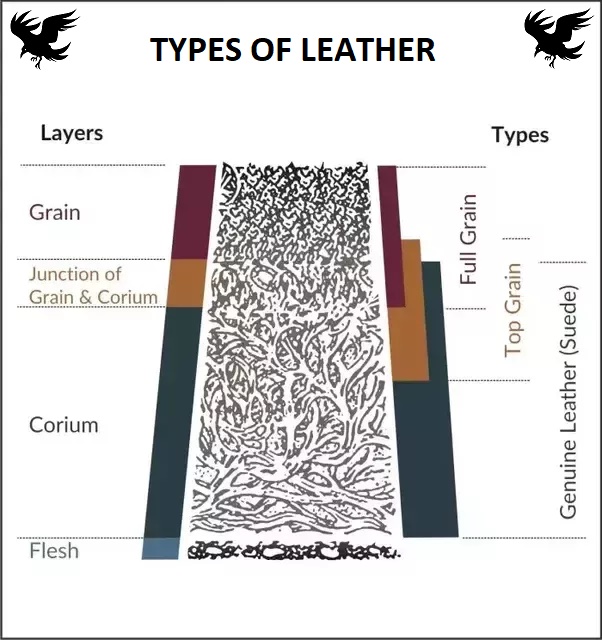Types of Leathers
In selecting the right type of leather-based product, or shopping for ready-made leather-based merchandise, it is very important perceive the assorted forms of leather-based produced as we speak. Earlier than shifting on to the kinds or leather, listed here are some phrases you would wish to know.
Hide – A hide or skin is an animal skin treated for human use.
Grain – is the top part of the leather after being split.
Split – Is from the lower layers of the hide that have been split away from the upper, or grain, layers.
The hide is divided into different sections:
Back: The back consists of the shoulder and the butt.
Shoulder: the shoulder is a softer area of the hide.
Butt: The butt is the thickest and strongest part of the hide.
Belly: The belly is a stretchy soft leather of varying thickness.
Following are the main types of Leather explained to you by BLACKBIRD LEATHERS
1: FULL GRAIN LEATHER
Full-grain describes the leather retaining the imprints original to the hide and the animal it was taken from. It is formed by removing the hair present on the skin of the hide. No polishing and finishing is done to the grain of the leather. Although there might be imperfections on the leather, it retains all of the original texture and markings of the original. This leather also tends to feel better over time. Due to its rarity and quality, Full-grain leather is one of the most expensive forms of leather available in the market. types of leathers
2: TOP GRAIN LEATHER
Top grain leather is the second highest grade of leather, which has its outermost layer of the hide. It is the second-highest grade of leather because it is split from the top layer of blemished hide, then sanded and refinished. Unlike Full Grain, Top grain leather does not age nicely with use. It is strong and durable, but may not hold up well with frequent use. As top grain leather does not have the strongest fibers of the hide, it can be easily pulled apart. types of leathers
3: SEMI ANILINE LEATHER
Semi-aniline leather is slightly pigmented. This type of leather treatment gives it a light surface protective coating. This coating protects the leather from scratching.
One downside of a semi-aniline finish, is that the added pigment uniforms the coloring, taking away some of the natural elements to the leather. The protective coat would protect the leather but would also make it harder to breathe and patina over time. types of leathers
4: SUEDE
Suede leather is made from the inner surface of the animal hides, visible on the underside of leather. Suede leather can be made from any animal hide but the most common is lamb, goat, deer, pig and calf. The type of animal has an effect on the finish of the suede. The thin innermost layer is cut off to create a thin, soft material.
Suede is rather durable and it is less expensive than Nappa or Nubuck. However, it gets dirty easily and is difficult to clean. types of leathers
5: GENUINE LEATHER
Genuine Leather is the third grade of leather and is produced from the layers that remain after the top is split off for the Full Grain and Top Grain layers. The surface is usually refinished to resemble a higher grade. Genuine leather can come from intermediate layers – between the top grain and suede. Genuine leather is simple to maintain and can last up to several years if properly cared for. types of leathers
6: BONDED LEATHER
Bonded leather is made from mixing shredded leather scraps and fibers, similar to the production of paper. It is then formed into a roll using adhesive or other bonding materials and extruded onto a fiber or paper backing cloth. After the roll is formed, it undergoes drying to reduce its moisture content. Since it usually contains 10 to 17 percent leather fibers, some industry experts expressed that they do not consider it as real leather.
Bonded leather is good for its comparatively low cost. types of leathers
7: BI-CAST LEATHER
Bi-cast leather is made from using the lowest layers, “split” of the hide. This lowest layer is too thin or flawed for normal use as it lacks strength. Bi-cast leather also lacks the natural beauty of the top-grain layer. This layer is covered with a layer of polyurethane (constituents of paints, varnished, adhesives and foams) and afterwards being embossed to look like real leather.
Bi-cast leather does not demonstrate any of the same wear or comfort attributes of top grain. However, it can still serve as an economical alternative for people wanting the look of the leather without the price.
It is much less expensive and less durable compared to genuine leather. types of leathers
8: FAUX
Faux leather is not real leather. It is man-made leather made from synthetic materials such as plastic and rubber-coated fabric. Through technology, Faux leather has resulted in great improvement in the material composition, thus increasing the comfort level of sofas. It is durable and it looks like original leather however, it is the cheapest type of leather for furniture.
To differentiate faux leather from real leather, drop a small amount of water on the product, as leather absorbs moisture. If it is faux leather, the water will simply puddle up on top. While real leather would absorb the water.

BLACKBIRD LEATHERS offer Full grain Natural leather products to its costumers with LIFETIME warranty. if you like this article then FOLLOW us on Facebook. To see our PRODUCT LIST CLICK HERE. types of leathers

